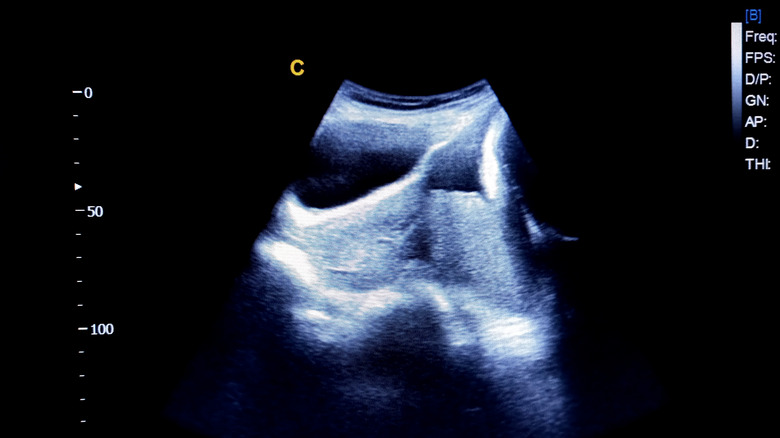Placenta Previa Explained: Causes, Symptoms, And Treatments
To understand placenta previa, a condition seen in around 1 out of 200 pregnant women (via the American Pregnancy Association), we first need to understand a little about that mysterious and unique organ, the placenta. Susan Fisher, professor of reproductive sciences at University of California San Francisco, goes as far to say that, "Compared to what we should know [about the placenta], we know almost nothing. It's a place where I think we could make real medical breakthroughs that I think would be of enormous importance to women and children and families" (via The New York Times). According to the Human Placenta Project, "The placenta is arguably one of the most important organs in the body. It influences not just the health of a woman and her fetus during pregnancy, but also the lifelong health of both mother and child." The site adds, though, that "Despite its importance, we know little about this critical but temporary organ."
So, what do we know about this one-of-a-kind organ? The placenta functions as a barrier as well as a conduit for oxygen and nutrients to flow from the mother to the embryo or fetus (via Placenta Function). Besides nourishment, it provides waste disposal (via The New York Times). This is critical because the placenta essentially does the job of liver, kidneys, and lungs until those fetal organs can function on their own. A placenta is initially developed from embryonic cells, and attaches to the uterine lining, with the umbilical cord connecting it to the baby. Later, after birth, the placenta is ejected after the newborn, hence the term "afterbirth."
What is placenta previa?
According to the Birth Injury Help Center, placenta previa is a rare condition which impacts less than 1% of the pregnant population. During pregnancy, the disc-shaped placenta grows from the embryo, attached by the umbilical cord, and implants itself to the wall of the uterus. Normally, the placenta is attached along the top or side of the uterus. In cases of placenta previa, however, the placenta is positioned lower, in such a way that it partially or fully covers the cervix, which is the opening to the vaginal birth canal. Although placenta previa is rare, it is associated with several potentially serious maternal-infant risks. Research published in the Journal of Medical Ultrasonics does, however, suggest that a large percentage of placenta previa presentations self-correct by the end of pregnancy as the placenta migrates with fetal growth. Researchers emphasize the importance of having a third-trimester ultrasound to update placenta previa diagnosis and plan for delivery.
Symptoms of placenta previa
You may be wondering what the signs or symptoms of placenta previa are. Symptoms can vary from case to case, but the most common sign of placenta previa is painless, late pregnancy bleeding (via the American Pregnancy Association). Other potential symptoms include premature contractions, uterine measurements that are larger than expected for gestational age, and breech or transverse fetal position. The majority of the time, however, placenta previa symptoms are not present and diagnosis is made via routine ultrasound (via March of Dimes). Roughly one third of placenta previa cases are diagnosed without bleeding. For those who do experience symptoms like bleeding, however, it is important to seek medical care immediately.
Painless, bright red vaginal bleeding due to placenta previa can at times be triggered by sexual intercourse, medical vaginal exam, or labor (via Placenta Previa). At other times, the bleeding will begin with no identifiable cause. Bleeding as a symptom of placenta previa most often occurs during the second or third trimester. If placenta previa has already been diagnosed via ultrasound, your provider may suggest a digital examination as opposed to an internal speculum examination.
Risk factors for placenta previa
Although there is no identified cause of placenta previa, there are a number of risk factors associated with the condition. A 2021 study in the Journal of Family Medicine and Primary Care cited the most identifiable risk factors for placenta previa as advanced maternal age, a history of uterine scarring, or pregnancy with twins or multiples. A larger research review published in Placenta indicates that other risk factors include smoking, a male fetus, or a history of prior abortion or miscarriage. Placenta previa during pregnancy may also be more likely to occur in patients with a history of previous pregnancy, previous cesarean section delivery, or a history of other reproductive surgeries such as curettage or myomectomy (via March of Dimes). Cocaine use is also a potential risk factor for the development of placenta previa. There is currently no clear medical guidance around how to prevent placenta previa, but avoiding smoking and cocaine use may reduce risk of developing the condition during pregnancy.
Types of placenta previa
During most pregnancies, the placenta develops and attaches to the upper or side portions of the uterus. In those with placenta previa, the pregnancy attaches lower than is typical along the uterine wall. There are three different types of placenta previa: complete previa, partial previa, and marginal previa (via the American Pregnancy Association).
In cases of complete previa, the placenta attaches low enough within the uterus so that the entire cervical os (or opening to the vagina) is completely blocked. With partial placenta previa, the cervix is partially covered by the placenta. Finally, marginal previa means that the disc-shaped placenta attaches in a placement that only blocks the edge of the cervical opening.
According to the New England Center for Placental Disorders, placenta disorders are typically diagnosed during the second trimester of pregnancy via ultrasound. (This highlights the importance of regular prenatal screening). The more the placenta eclipses the cervical opening, the less likely it is to correct itself without maternal-infant risk by the time of delivery.
Potential complications for the fetus
When a placenta implants low enough along the uterine wall to completely or partially block the cervical opening to the birth canal, this can create risks to the fetus (via the Birth Injury Guide). Potential complications that may impact fetal health include congenital abnormality, respiratory distress syndrome, preterm birth, low birth weight, infant anemia, or even stillbirth.
New research from the Nassau University Medical Center has indicated a 3 to 4 times increase in neonatal death rates in cases of placenta previa, as opposed to other pregnancies. This is largely due to preterm delivery. Because of these and other safety risks associated with placenta previa, a surgical or cesarean birth is often medically indicated. If you have been diagnosed with placenta previa, your medical providers should discuss these risks and create a birth and treatment plan ahead of time, during prenatal care. Very often, a cesarean section will be scheduled for between the 36th and 37th weeks of pregnancy.
Potential complications for pregnant people with placenta previa
There are significant maternal risks associated with placenta previa, especially during labor. According to Placenta Previa, bright red, painless vaginal bleeding can occur during pregnancy with placenta previa during the third trimester, presenting a risk of maternal hemorrhage or preterm labor. Beyond this, because the placenta implants near or on the cervix, blood vessels attaching the placenta to the uterus can tear and cause bleeding as the cervix thins and opens during labor to allow birth (via the Birth Injury Guide). In the majority (roughly 90%) of placenta previa cases, the placenta will move on its own prior to delivery. However, those with the condition will need to be monitored closely, as maternal hemorrhage, need for blood transfusion, hysterectomy, and death are possible, particularly in cases with anterior placenta placement or other increased risk factors (via Placenta Previa). For this reason, appropriate prenatal care is critically important for promoting safe birth outcomes.
How is placenta previa diagnosed?
In placenta previa, the placenta covers the cervical opening to the birth canal, creating potential risks. Placentas are visible via transvaginal (internal) ultrasound around six weeks and by regular or transabdominal ultrasound by 10 weeks of pregnancy, according to Contemporary OB/GYN. By 15 weeks it is very clearly visible. Placenta previa cannot accurately be diagnosed via imaging before 16 weeks. Though it's often discovered during a routine ultrasound, one symptom that sometimes prompts diagnosis is vaginal bleeding during the second trimester (via March of Dimes).
It's important to note that most placenta previa cases do resolve by the end of pregnancy (via Contemporary OB/GYN). Regular prenatal care is key, including recommended ultrasounds, in order to ascertain whether placenta placement is a concern for maternal or infant health. Although a surgical cesarean birth is indicated with full term placenta previa, if the placenta is no longer covering the cervical os by the time of birth, vaginal delivery is possible.
Treatment for placenta previa
After a placenta previa diagnosis, prenatal care and visits will increase. According to the American Pregnancy Association, steroid shots may sometimes be administered to help the fetal lungs mature, since any uncontrolled bleeding will call for immediate delivery regardless of fetal development stage. The majority of medical providers will also recommend avoiding sexual intercourse and pelvic exams, and traveling as little as you can. For some cases, bed rest may be prescribed. If bleeding is uncontrolled, an emergency cesarean section will be done no matter the stage of pregnancy.
While increased prenatal monitoring is generally the main treatment for placenta previa, social support may also be helpful. Your medical provider may refer you to support groups for parents navigating the diagnosis. This can help with some of the fear and anxiety that parents often feel when a pregnancy complication is diagnosed. Remember that this diagnosis impacts around 1 in 200 pregnancies, so you are not alone if you are navigating placenta previa.
Contact your doctor if you have concerning bleeding
If you are spotting while pregnant, you should contact your medical provider. According to the American Pregnancy Association, while some light pink discharge, bleeding, or light spotting can be normal during pregnancy, heavier bleeding may be a cause for concern. Some of the potential causes of vaginal bleeding include cervical polyps or implantation bleeding. Sexual intercourse, a gynecological exam, or heavy lifting could also be the reason for bleeding. Around 50% of bleeding that occurs is not dangerous, and these pregnancies result in healthy, full-term babies. However, third trimester bleeding and heavy bleeding in particular warrant immediate care in case of complications. Research indicates that placenta previa is becoming more common, perhaps due to increased cesarean section birth rates (via the Medical Science Monitor). Since maternal hemorrhage, emergency hysterectomy, or blood transfusions are risks with placenta previa, seeking immediate medical care for bleeding during pregnancy, even if you do not have an official placenta previa diagnosis, is wise.










